HAIL DAMAGE TO ROOF SHINGLES
By
Charles C. Roberts, Jr.
Hail forms when frozen water drops are lifted in turbulent wind
regimes during thunderstorms. The frozen drops of water increase
in size and eventually fall to earth as hail having been driven by a
combination of gravity and wind forces. Hail stones vary in size
from pea size (1/4 inch diameter, little roof damage), through
marble size (3/4 inch in diameter, threshold damage to roof
materials) to golf ball size (11/2 inch in diameter, typically severe
damage to roofing materials). Hail size distributions tend to be
localized with some roofs damaged, while others are not. Wind
direction plays an important role, as well as roof pitch. A direct
impact of hail on a shingle is more damaging than that of a
glancing blow. Figure 1a illustrates the dynamics of
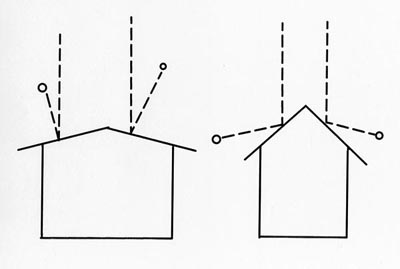
Figure 1a
hail impact on two different roof pitches. The home on the left
would sustain more roof damage than that on the right, because of
the more direct impact on the left as opposed to the less damaging,
glancing, blow to the right. Wind conditions can distort damage to
a home as illustrated in Figure 1b. The home on the left has more
glancing blows to the roof from the
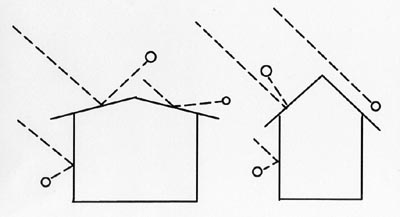
Figure 1b
wind, while the windward wall comes under attack from direct hail
impact. The right wall is protected and undamaged from the hail.
The home on the right will more likely sustain roof damage on the
windward side because of the more direct impact. Assessing hail
damage is often accomplished by a roof inspection, which usually
occurs several days to several months after the hail event.
Determination of whether hail actually fell at a site can be made
through statements and weather reports. Inspection of thin,
aluminum fixtures helps verify hail impact. Figure 2a shows
denting on a roof vent cap indicating that hail had struck the vent
at one time.
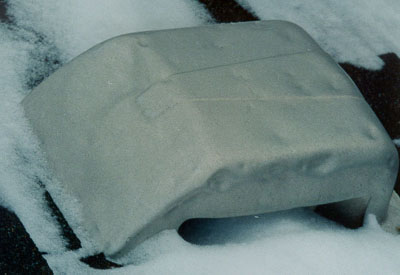
Figure 2a
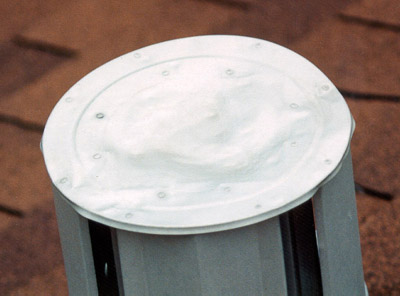
Figure 2b
Figure 2b shows denting on a flue vent indicative of hail impact at
one time. The denting on these two fixtures does not impede their
function.
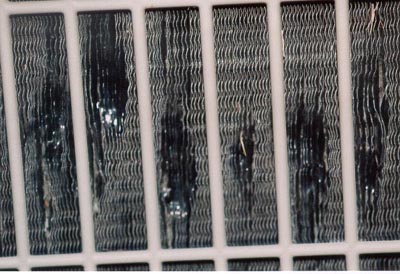
Figure 2c
Figure 2c shows deformation to condensing unit fins on an air
conditioning system, as a result of a driving hailstorm. This
damage does impair operation of the unit, in that air flow through
the coils is reduced, causing higher refrigerant temperature, lost
performance and lost reliability.
Figure 3 shows shredded and pock-marked paint from a driving
hailstorm. The base wood was undamaged but repainting was
required.
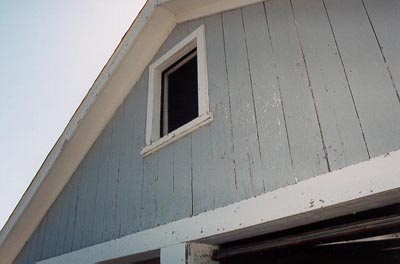
Figure 3
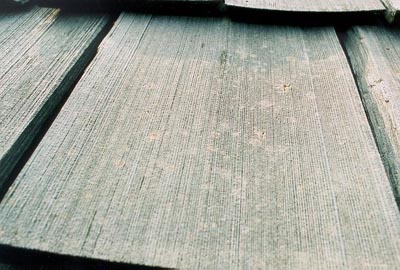
Figure 4
Figure 4 shows mild impact marks on a cedar shingle, consistent
with hail impact. These marks will typically dissipate over time
with virtually no effect on shingle life. Figure 5 shows more
severe shredding from hail impact. If the impact marks are causing
severe splits, then shingle life will most likely be adversely
affected.
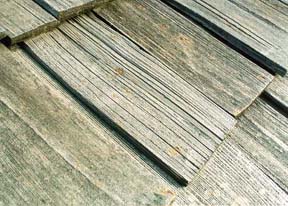
Figure 5
Figure 6 shows impact damage to siding as a result of wind driven
hail. Some shredding and minor splitting has occurred but the
siding appears structurally sound.

Figure 6
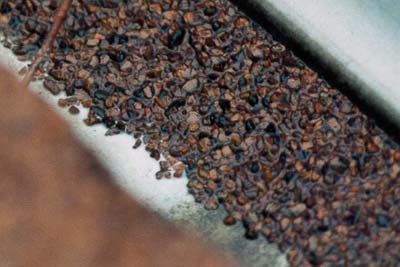
Figure 7
Hail damage to asphalt shingles includes severe granule loss,
material removal at the edges of the shingles and penetration.
Figure 7 shows grit loss from asphalt after pounding from a
hailstorm. New asphalt shingles are more resistant to hail impact
than older shingles since the asphalt becomes more brittle with
age. Warmer shingles are more compliant and more resistant to
fracture from hail when compared with colder shingles. Shingles
rely on a structurally sound substrate for hail damage resistance.
Flexible roof sheathing allows the shingles to flex during impact
causing damage, while more rigid roof sheathing supports the
shingle during impact resulting in less shingle damage.
In recent years, roof shingle manufacturers have been listing
products that conform to Underwriters Laboratories test standard
UL 2218, which classifies the resistance of a particular product to
hail damage. The test entails dropping steel balls on samples and
observing the damage. A Class 4 rating is the most resistive to hail
damage, while the Class 1 rating is the least resistive. Some
insurance companies are reducing premiums when Class 4 shingles
are used. The roofing industry takes issue with some of the testing
methods, indicating that shingle aging and thermal environments
are not taken into account.
Most hail related damage is cosmetic and does not affect the useful
life of roof shingles. In other cases severe wood splitting,
significant granule loss, penetration of the shingle and fracture may
require shingle replacement.
FOR TECHNICAL ARTICLES CONTACT CLAIMS MAGAZINE AND ASK
FOR A REPRINT OF A PAST TECHNICAL NOTEBOOK ARTICLE
CLAIMS MAGAZINE










